“Life with a Star” - Part 3: Sun Watching Devices
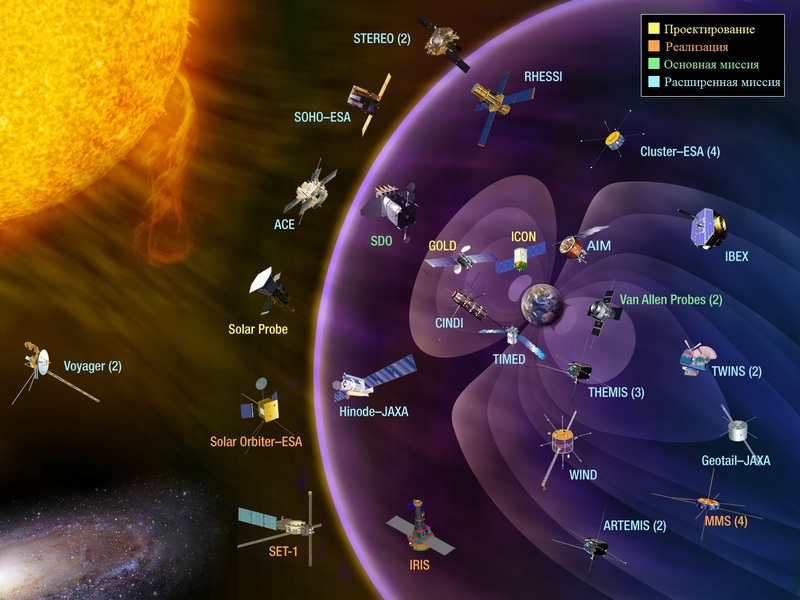
In the continuation of articles on solar activity and space weather, I will talk about automatic devices, which allowed us to significantly advance in the study of these processes.
Despite the fact that the Sun is perhaps the most important object of the Solar System for us (after the Earth, of course), the number of probes aimed at its study is inferior to the same number for Venus and Mars. However, taking into account the fact that a significant part of the spacecraft sent to Venus and Mars were lost, and the average time of their operation did not exceed a couple of years (compared to many spacecraft exploring the Sun for decades), the situation in the research spacecraft indicator is still in favor Of the sun. Moon 1
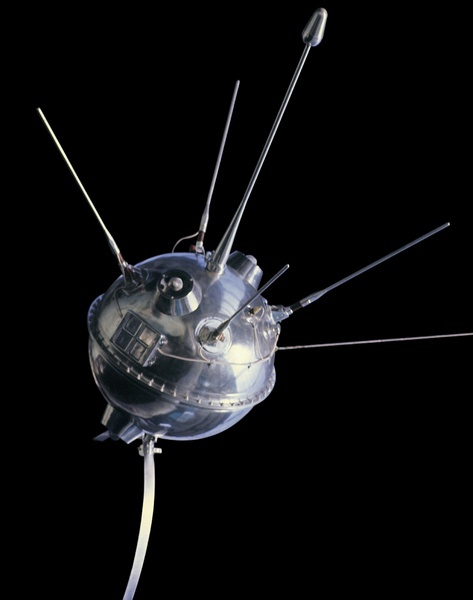
- launched on January 2, 1959. Despite the fact that the main goal (getting to the moon) failed, her mission was very successful. One of the achievements of this apparatus is the first ever direct observation of the characteristics of the solar wind .

Pioneer-5 - made the first measurements of the interplanetary magnetic field, the level of radiation and the properties of solar flares. Despite the quick failure (he worked in orbit from March 11 to April 30, 1960), this tiny satellite weighing 45 kg with a diameter of 66 cm is considered the most successful of the entire Pioneer satellite series.
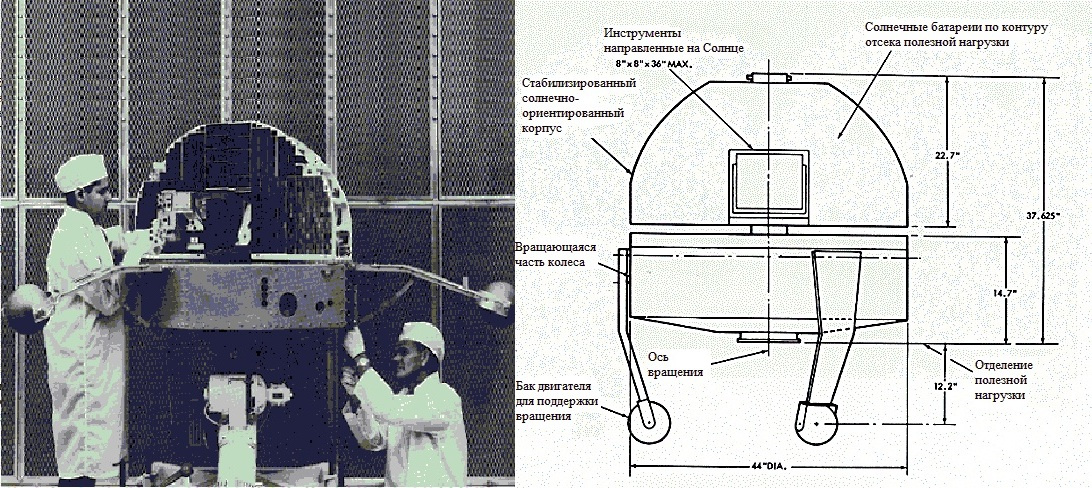
Series of satellites "orbiting solar observatory» ( Orbiting Solar Observatory) Is 8 consecutively launched apparatuses aimed at studying 11-year cycles of the Sun in ultraviolet and X-rays. From the launch of the first observatory on March 7, 1962 to the end of the last of them in October 1978, usually 2-3 orbits of this series were in orbit. The orientation of the devices on the Sun was carried out by rotation.
A serious accident is connected with the second device: on April 14, 1964, on the tests of integration of the device with the third solid-fuel stage of the Delta-C rocket, one of the technicians accidentally set it on fire with a discharge of static electricity, during this accident three people burned, and the device ricocheted off the roof fell in a corner of the building . It took 10 months to restore it, after which it was still launched on February 3, 1965.
The third device had to be made in two copies at all, since modifications in the third stage of Delta-C (made after the previous case) led to its premature launch in flight, and the device itself burned down in dense layers of the atmosphere. Despite this, the new “third” device was able to establish the uniformity of gamma radiation throughout the sky, and also detected X-ray flashes from the Scorpius X-1 object . The sixth apparatus was one of the first to detect gamma-ray bursts , the seventh detected gamma rays in solar flares, and the eighth detected iron lines in clusters of galaxies. Pioneer-6-9
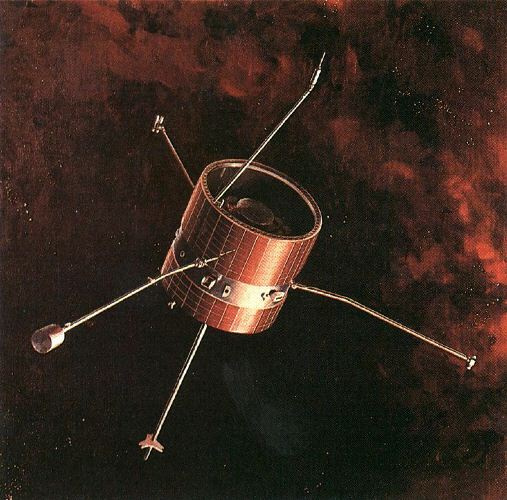
series spacecraft (their launches were carried out from December 16, 1965 to November 8, 1968) - these automatic interplanetary stations performed long-term measurementsspace weather , solar wind and cosmic rays . They can be attributed to the first "long-term" scientific missions - the last connection with the Pioneer-6 apparatus was established on December 8, 2000 (in honor of its 35th anniversary).
Presumably with the exception of the Pioneer 9 that failed in 1983, they are still functional. The main reason for refusing to use them further is the archaic nature of instruments (the capabilities of which were blocked by new satellites) and communications equipment (requiring huge plates at a communication speed of 512 bits / sec).
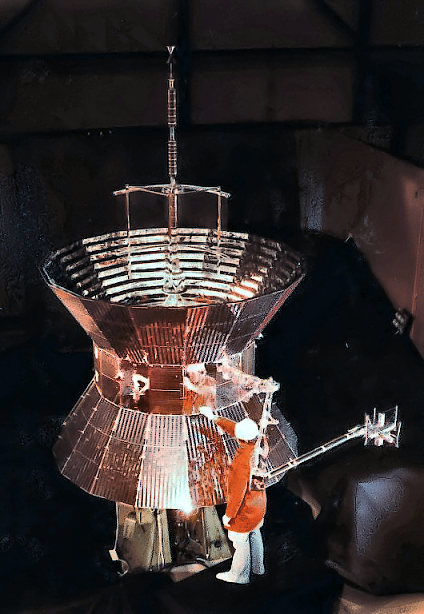
A pair of devices of the Helios series (launch on December 10, 1974 and January 15, 1976) is a joint development of NASA and DFVLR (then still part of Germany ). They studiedinterplanetary medium including studies of cosmic dust , cosmic rays, interplanetary magnetic field. Using them, helium ions were also first discovered in the solar wind.
For a more detailed study of the Sun, they were sent to a heliocentric orbit with a perihelion of 0.3 astronomical units (no one had come so close to the Sun from the AMS ). The devices managed to detect “magnetic clouds” from the plasma (together with another satellite - SMM ), however, their origin could not be associated with coronal mass ejections at that moment. International comet researcher - launched on August 12, 1978, was the first device launched in Lissajous orbit.
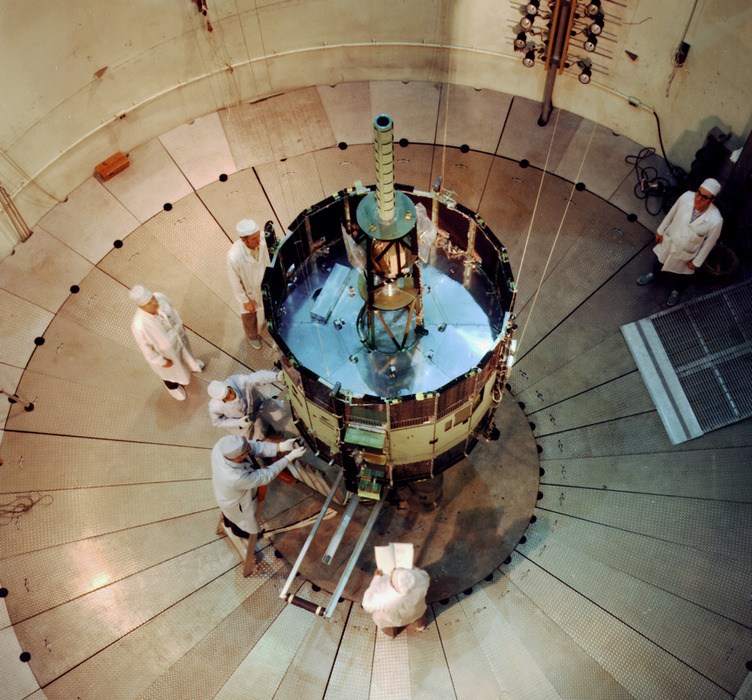
on which it rotates around the point L 1 located between the Earth and the Sun. The device has three cosmic ray detectors of different energies, detectors of protons and magnetic fields, plasma waves and x-rays. After completing his main mission on the study of solar-terrestrial connections, solar wind and cosmic rays on June 10, 1982, he was sent to study the comet Jacobini-Zinner , whose tail he passed on September 11, 1985.
May 5, 1997 the device was sent to NASA "retire" with the shutdown of all scientific instruments. In 1999 and 2008, NASA checked its condition. In April 2014, on the crowdfunding platform RocketHubThere was a project to restore communication with this device, which raised nearly $ 160 thousand. As early as May 29, 2014, this team managed to establish communication with the device (with the permission of NASA, of course). And on July 2, they tried to start his engines for the first time since 1987, but this was not possible due to a lack of nitrogen for boosting the tanks. The team continued to work with scientific instruments until September 16, when contact with the device was lost. Presumably this happened due to a decrease in the energy released by solar panels, since the device flew at that moment past the Earth, flying away from the Sun (so communication with the device was already lost in 1981). The next meeting of the device with the Earth is due to happen in 2031. Voyager 1 and 2

- although the main purpose of these devices was to study the outer planets of the Solar System, they also contributed to the study of the Sun: they were used to clarify the properties of the solar wind at different distances from the Sun, the propagation velocity of coronal emissions of matter and the location of the head shock wave of the Solar System (places where the solar wind collides with the interstellar medium). Solar Maximum Mission (also known as SolarMax
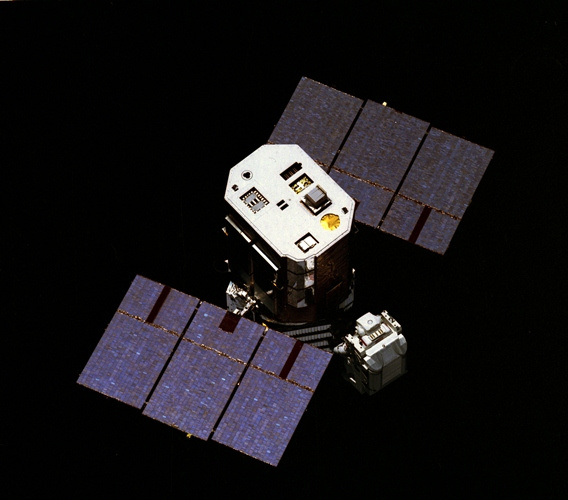
or just SMM) was launched on February 14, 1980 to study solar phenomena. By June 21, he was able to detect neutrons generated during a solar flare (this is a rather rare event and is recorded on average once a year) and also quickly fail - in November. The device lost orientation on the Sun and spent in this state until April 1984, when the Space Shuttle mission STS-41-C did not fix it.
It was not possible to immediately catch the satellite for repair: in the beginning they tried to do this with the help of a maneuvering shunting module ( MMU , unfortunately after the Challenger disaster they refused to use it at all), then they tried to use the Canadarm manipulator. As a result, they managed to dock only the next day after the device issued signals from the ground and reduced its rotation frequency.

The entire mission of the Shuttle was ultimately successful and the satellite’s orientation system with one of the scientific instruments was repaired, as well as its photograph presented above. Despite such an alternative mission emblem (indicating the landing date, made on Friday the 13th), SMM worked until it entered the atmosphere on December 2, 1989, simultaneously opening several near-solar comets.
The apparatus also managed to establish that during the solar maximum (when the number of sunspots sharply increases), the luminosity of the Sun does not fall, but rather increases - this is due to the presence of solar flares around the spotwhich conversely have increased luminosity.

AMC "Ulysses" - launched on October 6, 1990, a joint project of ESA and NASA. This was the first device launched at a large angle to the plane of the ecliptic of the solar system. His tasks included the study of the poles of the Sun and a little Jupiter (during the gravitational maneuver to enter the required orbit and fly by in 2004). The device was able to establish that the south pole of the Sun does not have a fixed position (as well as the north one), and after passing through the tails of several comets he managed to establish that their length can extend several astronomical units in length.
But everything has its own price, and Ulysses inferred as the main loadThe space shuttle "Discovery" (having a load capacity of 24.4 tons per DOE) and accelerated by two additional steps, had a total mass of only 365 kg of which only 55 kg fell on scientific equipment. In this regard, the apparatus had a very limited set of devices: detectors of ions and electrons, cosmic dust and rays. This list did not include any cameras, so we still do not have any photographs of the poles of the sun.
Since the Ulysse AMS during the launch into orbit had to move as far as Jupiter, the RTG was used as a power source, and since the mass of the device was very limited, its power was very small. Thus, a decrease in the power of the RTG led to the fact that even 70-meter plates of the space communications networkNASA at the end of the device’s life began to lose its signal, and in 2008, a decrease in its power completely caused the fuel (hydrazine) to freeze, the device was unable to maneuver and was lost (although it had already worked for 17 years and exceeded its estimated life by 4 times) .
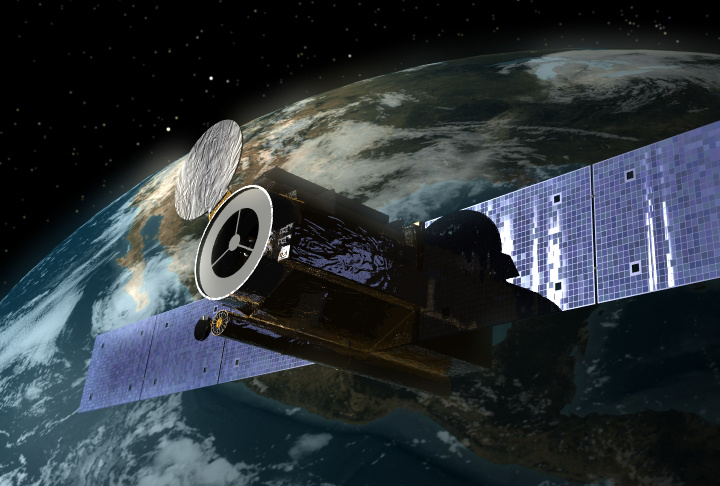
Solar-A and Solar-B are devices that, after launch, received the more consonant names “Yohkoh” (Sunbeam) and “Hinode” (Sunrise). This is a joint project of Japan, the UK and the USA. The devices for this project were launched on August 30, 1991 (worked until December 14, 2001) and September 23, 2006 (still continues to work).
"Sunbeam" first had a CCDamong space X-ray telescopes, and also had another x-ray telescope of a harder spectrum and a couple of spectrometers to search for ions of iron, sulfur and calcium. "Sunrise" received a 0.5 meter optical and X-ray telescope, as well as an ultraviolet spectrometer.
The main goal of the work of both devices was to study the magnetic field of the Sun through its various manifestations. The second apparatus was able to detect Alfvén waves on the Sun, and also find direct evidence that magnetic reconnection is a source of solar flares. Coronas Series
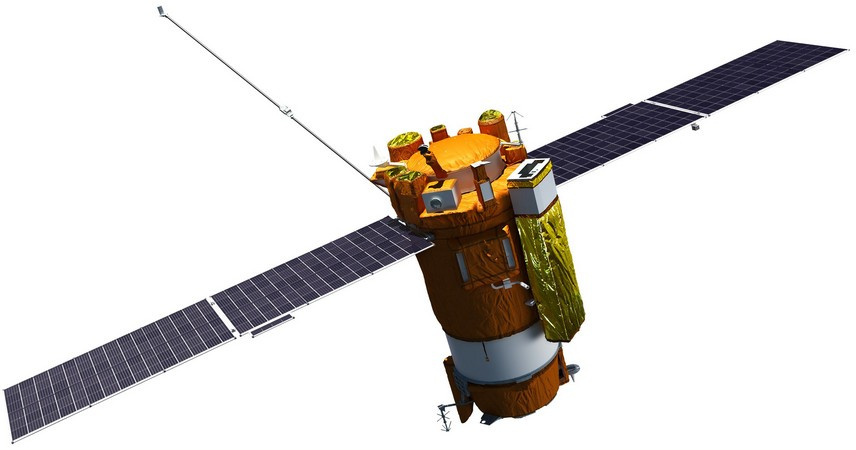
- A joint project of Roscosmos and the Russian Academy of Sciences (and earlier also of Ukraine), which provided for the study of the Sun during one 11-year cycle. The research program was to be carried out by successively launching 3 devices: Koronas-I, Koronas-F and Koronas-Foton. The devices had a wide range of tasks: the study of various manifestations of solar weather, seismological studies of the internal structure of the Sun, the study of the interaction of active phenomena on the Sun with the emissions of charged particles and their interaction with the upper layers of the atmosphere.
For this purpose, receivers of almost the entire spectrum of electromagnetic radiation were installed on the devices: from radio to gamma. In the creation of devices for him participated Russia, Ukraine, India and Poland. Funding problems forced the launch dates to be shifted, but the reliable operation of the first two devices made it possible to almost mitigate the consequences of this: Koronas-I launched on March 2, 1994 worked until March 2001, and Koronas-F launched on July 31, 2001 left orbit in December 2005 ( the shorter service life of the second spacecraft was caused by the influence of the solar maximum on the Earth’s atmosphere and, consequently, the faster braking of the spacecraft in low orbit, which in the case of both spacecraft was about 550 km).
However, the third apparatus ( Coronas-Photon) launched on January 30, 2009, it was less fortunate: it was able to work only 278 days and then crashed due to malfunctions of the Meteor platform (although all scientific instruments continued to operate). During the work of Coronas-Photon, 380 GB of scientific information was collected.
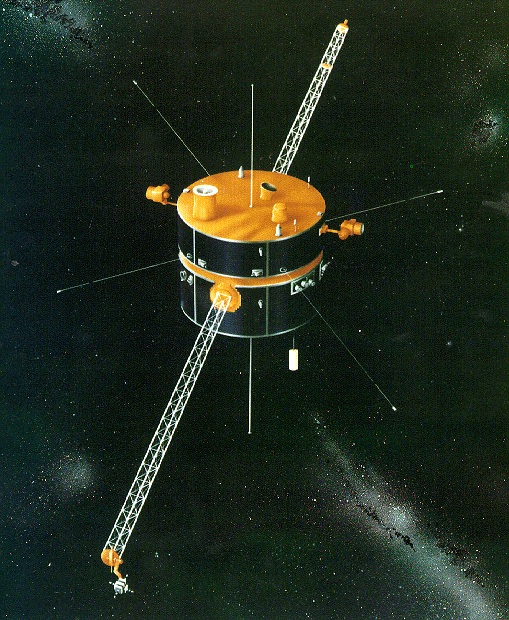
WIND was designed to study the solar wind. Although it was launched on November 1, 1994, until the next apparatus on this list, because of the scientists' desire to study the Earth’s magnetic field and the environment surrounding the Moon in more detail, he joined it at Lagrange point L 1 only after 10 years. WIND is 2.4 m in diameter with a height of 1.8 m and a dry weight of 895 kg, while stabilization of the device by rotation made it possible to install 2 “short” magnetometers in it 12 and 15 m long, and one long 100-metermagnetometer adjustable length of wire. The apparatus also has ion and electron detectors of two energy ranges and two gamma spectrometers, one of which was turned off due to depletion of reserves, and the other (manufactured by the Physicotechnical Institute of the Russian Academy of Sciences ) continues to work, as the apparatus itself has up to now. During this time, WIND became the source for 4,300 scientific publications. Residues from 300 kg of fuel to the device should be enough for another 50 years of being at point L 1 . SOHO is a joint project of NASA and ESA launched on December 2, 1995, which continues its work to this day. On board there are as many as 12 devices, some of which remain unique to this day (though the other part has already been disabled due to the launch of a newer SDO ):
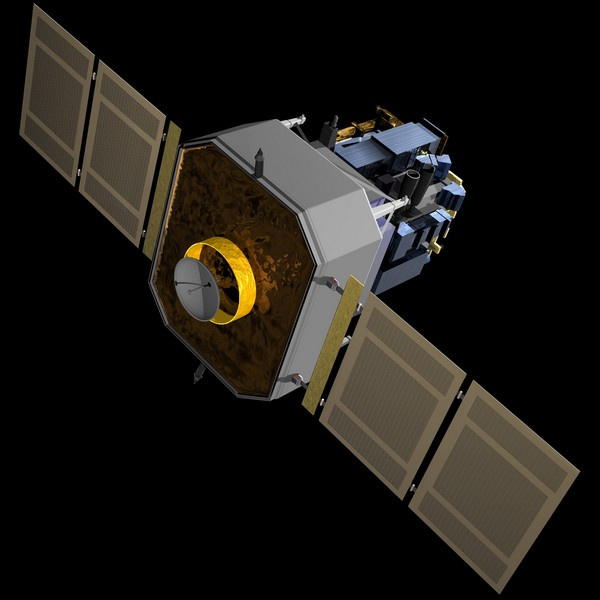

Description of SOHO instruments
CDS (Coronal Diagnostics Spectrometer - spectrometer for coronal diagnostics);
CELIAS (Charge, Element, and Isotope Analysis System - an analysis system of charges, elements and isotopes);
COSTEP (Comprehensive Suprathermal and Energetic Particle Analyzer - analyzer of hot and energetic particles);
EIT (Extreme ultraviolet Imaging Telescope - ultraviolet telescope);
ERNE (Energetic and Relativistic Nuclei and Electron experiment - experimental observation of relativistic nuclei and electrons);
GOLF (Global Oscillations at Low Frequencies - for observing the low-frequency global oscillations of the Sun);
LASCO (Large Angle and Spectrometric Coronagraph - wide-angle spectrometric coronograph). Three coronographs study coronal mass emissions. Also, with the help of these coronographs, many peri-solar comets have been discovered;
MDI \ SOI (Michelson Doppler Imager \ Solar Oscillations Investigation - Doppler shift meter). This tool receives maps of the magnetic field of the Sun and the velocities of matter at the height of the formation of the observation line;
SUMER (Solar Ultraviolet Measurements of Emitted Radiation - a tool for measuring the flow of ultraviolet radiation);
SWAN (Solar Wind Anisotropies - solar wind anisotropy meter);
UVCS (Ultraviolet Coronagraph Spectrometer - ultraviolet spectrometer);
VIRGO (Variability of Solar Irradiance and Gravity Oscillations - a tool for studying the solar constant and gravitational oscillations)
CELIAS (Charge, Element, and Isotope Analysis System - an analysis system of charges, elements and isotopes);
COSTEP (Comprehensive Suprathermal and Energetic Particle Analyzer - analyzer of hot and energetic particles);
EIT (Extreme ultraviolet Imaging Telescope - ultraviolet telescope);
ERNE (Energetic and Relativistic Nuclei and Electron experiment - experimental observation of relativistic nuclei and electrons);
GOLF (Global Oscillations at Low Frequencies - for observing the low-frequency global oscillations of the Sun);
LASCO (Large Angle and Spectrometric Coronagraph - wide-angle spectrometric coronograph). Three coronographs study coronal mass emissions. Also, with the help of these coronographs, many peri-solar comets have been discovered;
MDI \ SOI (Michelson Doppler Imager \ Solar Oscillations Investigation - Doppler shift meter). This tool receives maps of the magnetic field of the Sun and the velocities of matter at the height of the formation of the observation line;
SUMER (Solar Ultraviolet Measurements of Emitted Radiation - a tool for measuring the flow of ultraviolet radiation);
SWAN (Solar Wind Anisotropies - solar wind anisotropy meter);
UVCS (Ultraviolet Coronagraph Spectrometer - ultraviolet spectrometer);
VIRGO (Variability of Solar Irradiance and Gravity Oscillations - a tool for studying the solar constant and gravitational oscillations)
SOHO has a very unique and interesting history : the mission of the device was originally designed for two years, but when it started working in May 1996, on June 24, 1998, communication with the device was lost during the planned calibrations of gyroscopes (the device lost its orientation to the Sun, which it could not independently reestablish).
Since the device was very valuable and did not want to lose it, ESA specialists immediately went to the USA to be able to use the help of the NASA deep space communications network besides their plates . However, a whole month of daily attempts to communicate with the device did not produce results, and experts took an almost unprecedented step: using the 305-meter radio telescope in Arecibo at the same timefor transmission and the 70-meter Goldstone telescope for reception, for more than an hour they tried to establish the current position of SOHO. In the course of this, the device was found near the expected position, but the data showed that it rotates at a speed of 1 revolution in 53 seconds with solar panels having lost their orientation to the Sun.
Only by August 3, when the orientation of the solar panels was partially restored and the batteries of the device began to charge, a short signal was received from it a few seconds long. After charging both batteries on August 12, SOHO was instructed to turn on the tank heaters with hydrazine, which had already completely frozen by that time. The heating process had to be stopped several times since telemetry showed that the batteries were starting to discharge (the orientation of the solar panels was not accurate and they did not cover the energy needs of the heaters, but the “rescue team” SOHOI didn’t want to risk reducing the battery charge). After the process of warming up the fuel tanks and fuel pipelines, SOHO was again oriented to the Sun on September 16th. Then, a gradual restoration of instrument operability began: SUMER - was launched first on October 7, COSTEP and ERNE are on the 9th, UVCS on the 10th, MDI on the 12th, LASCO and EIT on the 13th, CDS and SWAN - 17- On October 23, and with the launch of the last device (CELIAS), the device fully restored its functionality.
However, this was not the end of his adventures: after the restoration of the working capacity of scientific instruments, it turned out that only 1 of the 3 gyroscopes of the device continues to work, and on December 21 the remaining gyroscope also failed. The ESA had to develop a new work program for SOHO so that it could continue to work without wasting precious fuel. Reprogramming of the device was carried out on February 1, 1999.
Despite such a start, a terrible start, the device continues to work without significant failures. But any equipment eventually becomes obsolete, and with the launch of SDO in early 2010, part of the SOHO devices that have common tasks with it began to be gradually turned off: already in July 2010, the EIT device was put into limited mode and takes only two sets of images per day (in order to maintain a continuous series of observations), since April 12, 2011 the MDI device was turned off, on January 23, 2013 - UVCS, on August 8, 2014 - SUMER, and on September 5 - CDS.
In addition to its main mission, SOHO with the help of volunteers helped open 2 thousand comets by December 26, 2010, and by September 13In 2015, their number exceeded 3 thousand - thus, with the help of SDO, more than half of all currently known comets were discovered.
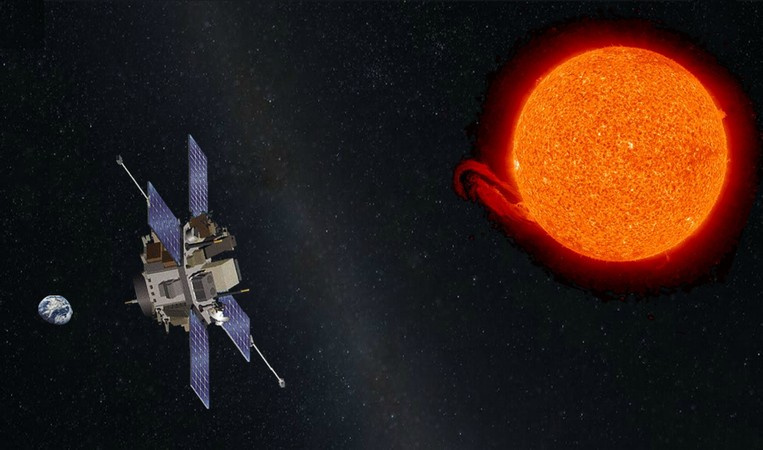
Advanced Composition Explorer is an apparatus launched on August 25, 1997 for studying high-energy particles of the solar wind and interplanetary medium. At the moment, ACE mainly serves to refine forecasts of magnetic storms half an hour or an hour before their arrival, due to its position at the Lagrange point L 1 1.5 million km from Earth on the Earth-Sun line. The location of this point also allows it to significantly save fuel: on August 15 it will be 20 years since its launch, and it has approximately 37 kg of fuel left, which should be enough for it before 2026 .
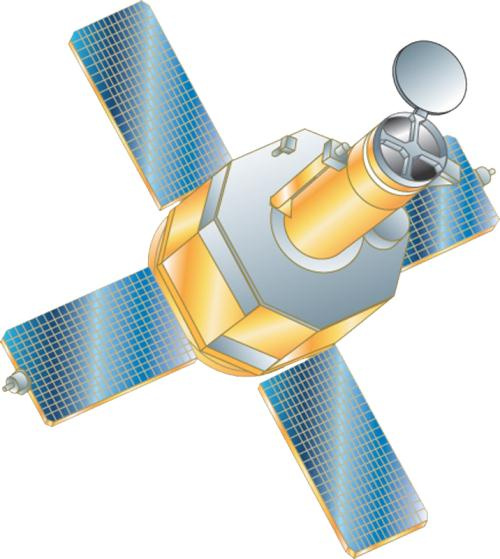
TRACE- This is a small telescope with an aperture of 30 cm launched on April 2, 1998 as part of the NASA Small Research Programs (SMEX) project, which provides projects for less than $ 120 million. The device imaged sections of the Sun in 8.5 angular minutes (about 14 part of its total area) using a CCD matrix with a resolution of 1000x1000 pixels in the range from visible to far ultraviolet. From April 20, 1998 until 2010, he searched for the links of magnetic fields with the plasma structure in the solar atmosphere (photosphere, chromosphere and corona).
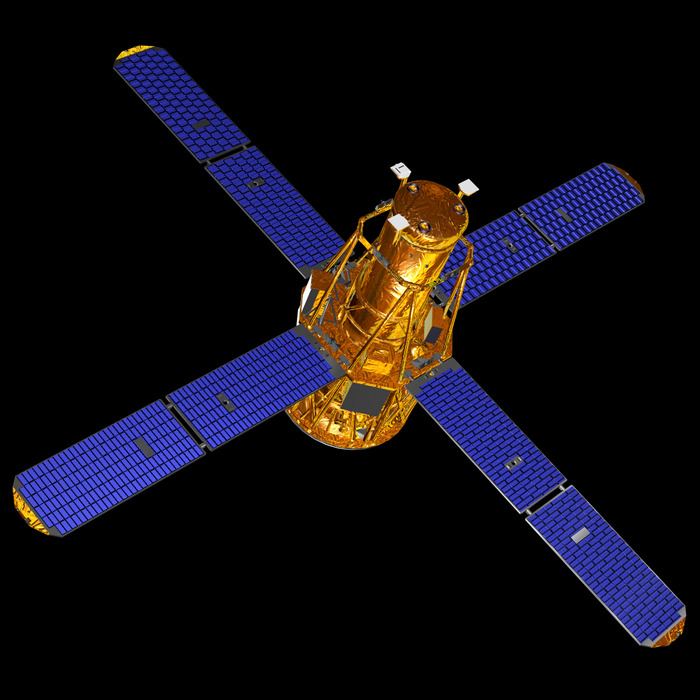
" Reuven Ramati Solar High Energy Spectrograph " or RHESI- X-ray and gamma spectrum observatory, aimed at studying solar flares, which was launched on February 5, 2002 under the SMEX program. For the first time she was able to capture gamma radiation from a flash and determine that the frequency of such gamma-ray bursts is more often than previously assumed. RHESI continues to work so far, and with the help of its data 774 scientific articles have already been written .
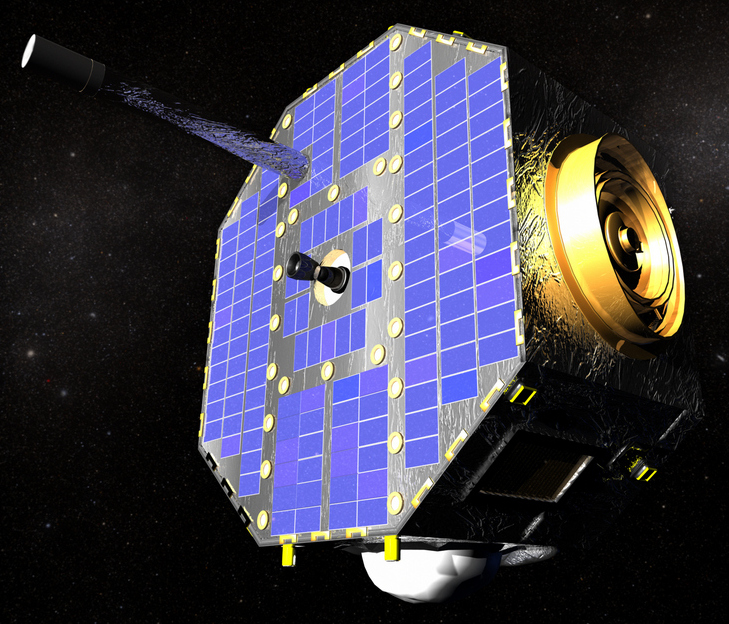
Interstellar Explorer or IBEX is a tiny satellite weighing only 80 kg launched from an airplane on a Pegasus rocketOctober 19, 2008 as part of the SMEX program. It has two detectors of neutral particles of high and low energies which are designed to measure the limits of the solar heliosphere. At the end of its main 2-year mission, the satellite managed to clarify the speed of our solar system relative to the interstellar medium (the measurement speed was 23.2 km / s compared to previously measured using the Ulysse AMS 26.3 km / s). And at the end of its expanded mission, IBEX discovered a plasma tail in the solar system. The satellite continues to work until now, the communication speed with it is only 16 kbit / s.

A pair of STEREO-A and B devicesLaunched in 2006, they include 4 sets of tools: SECCHI - for the study of the corona and heliosphere (one camera of the far ultraviolet spectrum and two pairs of coronographs and cameras for shooting the solar wind); IMPACT - coronary emission particle detectors; PLASTIC - detectors of protons, alpha particles and heavy ions; SWAVES - antenna for measuring disturbances in the radio range in the direction of the Sun-Earth.
The main task of these devices is to build 3D models of coronal mass ejections, which was very important for constructing a model of their formation (the fact is that solar flares and coronary ejections are always shot with different cameras, which makes it very difficult to connect them in 2D images between themselves). To carry out their mission, they were sent into orbits in the circle of the Sun with the expectation that one device would slightly outrun the Earth, and the other would be slightly behind it. Thus, they received a picture from two points equally spaced from the Earth, which gradually moved away. Since mid-2011, their distance from the Earth made it possible to obtain a complete picture of the Sun (until the STEREO-B apparatus lost its orientation on October 1, 2014):
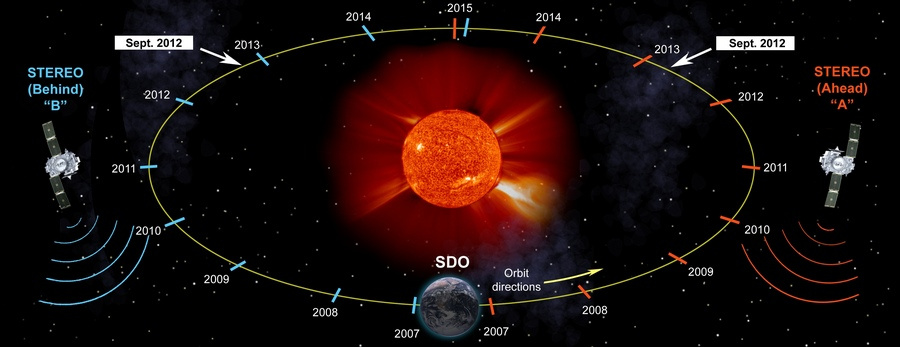
Since the apparatus had to move far away from the Earth during operation (up to 2a.e. ) for communication, they use directional antennas that must be accurately directed to the Earth. Problems with STEREO-B occurred during routine tests that simulate the loss of communication between devices during their passage beyond the Sun (the same problems are experienced by Mars rovers and satellites in Mars orbit that lose contact with the Earth for a couple of weeks when Mars sets behind the Sun).
Communication with the device was temporarily restored on August 21, 2016, but it was not possible to restore its orientation to Earth due to too fast rotation, since the moment of rotation of the flywheels to completely stop the rotation was not enough, and the MCC had no time to defrost fuel tanks until a new loss of communication . Unfortunately, the next opportunity to establish communication with him will appear only in 2022 (when his antenna is again directed to Earth). The mission team took into account the error and STEREO-A survived passing the connection with the Sun for several months in 2015 without any problems and continues to work as usual until now. PROBA2 - the second of a series of low-cost missions ESA 130-kilogram satellite which was launched on the rocket "Rokot"
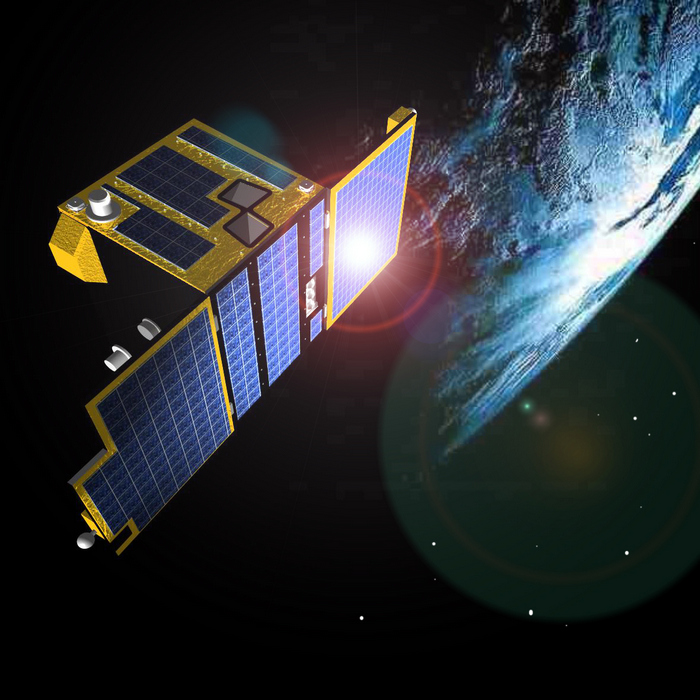
November 2, 2009. The device is a demonstrator of new technologies, carrying also 4 scientific experiments: a radiometer of the spectra of Lyman- alpha, aluminum and zirconium, a telescope of the far ultraviolet range with a CMOS matrix for studying the Sun; a DSLP detector for measuring electron density and temperature; and a TPMU detector for measuring the density and composition of ions in the Earth's magnetospheric plasma. Originally designed as a 2-year mission, according to current plans, it has been extended until the end of 2018. The Solar Dynamics Observatory ( SDO ) was launched into orbit on February 11, 2010 with an Atlas-5 rocket with an RD-180 engine
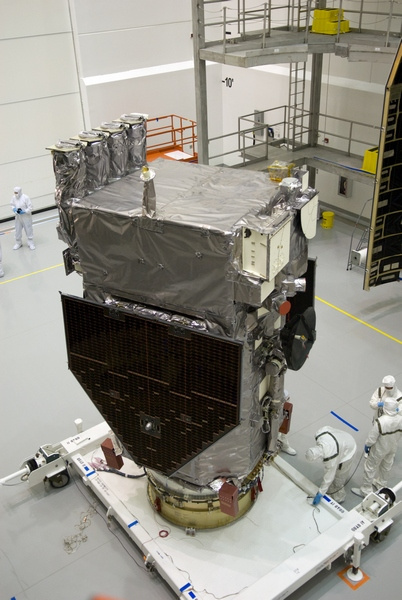
, after which it took its position in geosynchronous orbit. This observatory has on its board a magnetometer and 11 cameras of various ranges taking the entire surface of the Sun with an interval of 12 seconds and a resolution of 4096x4096 pixels, which gives a data stream of about 1.5 terabytes of data per day. Photographs of the Sun made by the observatory in 11 different spectral regions with an interval of less than a minute. Such a large data stream required special efforts to maintain it: the device has two highly directional antennas for data transmission and one separate for telemetry. Ground equipment consists of two 18-meter antennas designed exclusively for communication with SDO. Such a system allows you to have a total channel of 130 Mbit / s with two antennas at once. The device has its own website
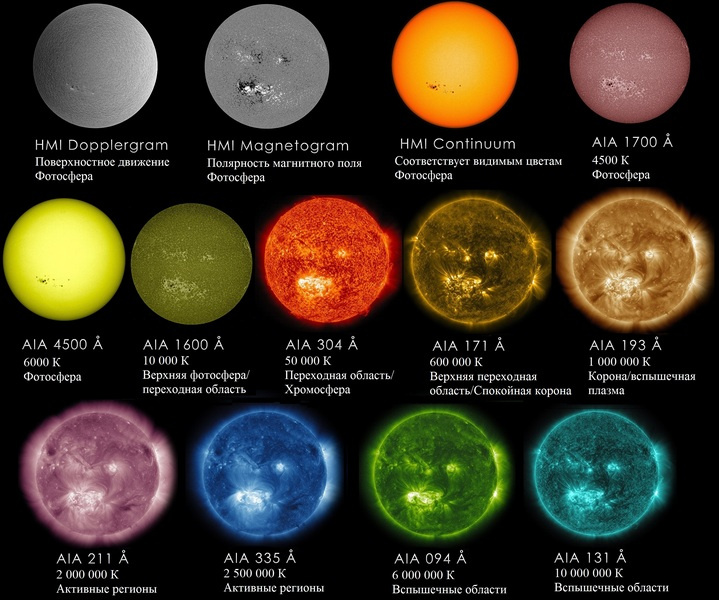
where you can see photos of the Sun in real time. And every year, around the “birthday” of the SDO, the Goddart Space Flight Center uploads a video composed of photos taken by him during this time: 1 year , 2 year , 3 year , 4 year , 5 year , 6 year , 7 year . Launched on February 11, 2015, DSCOVR , by June 8, it had already become the 7th device to reach point L 1 of the Earth-Sun system. The composition of this observatory includes a PlasMag instrument kit consisting of a magnetometer (pictured in the folded state), a Faraday cup
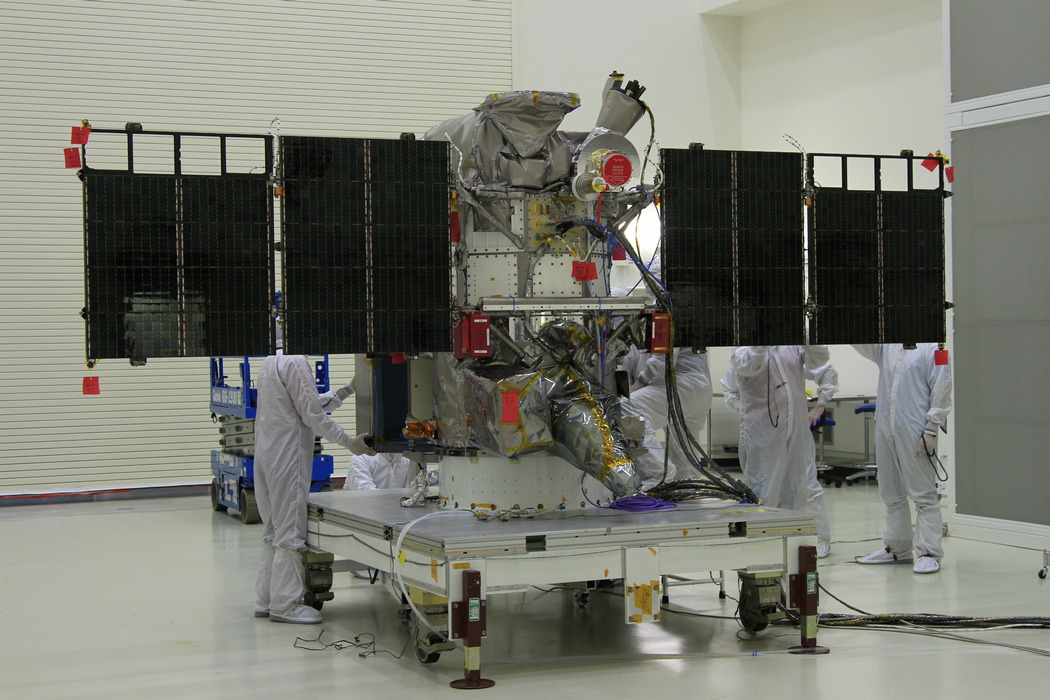
for recording positively charged particles; and an electrostatic analyzer for detecting electrons. The apparatus also includes a NISTAR instrument for measuring in 4 ranges the entire spectrum of sunlight reaching the Earth (to increase the accuracy of our knowledge about the influence of the Sun on Earth's climate changes) and an EPIC color camera that records the Earth in 10 color channels of visible light with a resolution of 2048 × 2048 pixels , with the help of which a lot of beautiful gifs are made on the Earth's rotation and the passage of the Moon in front of it (9 MB photo).
A list of current and planned NASA solar-terrestrial communications missions.
